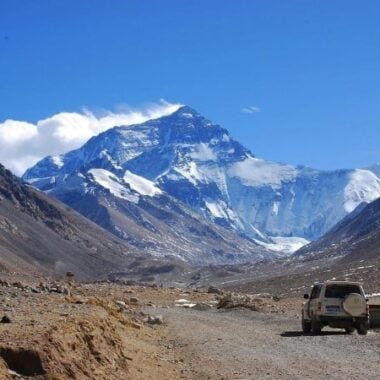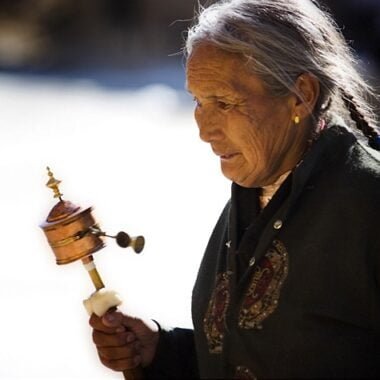Tibet Transportation: Your Guide to Traveling in the Land of Snow
Tibet, known as the “Roof of the World,” offers some of the most breathtaking landscapes on Earth, from majestic snow-capped peaks to…
Tibet, known as the “Roof of the World,” offers some of the most breathtaking landscapes on Earth, from majestic snow-capped peaks to serene high-altitude lakes. But reaching Tibet’s famous destinations, such as Mount Everest Base Camp (EBC) and Mount Kailash, requires careful planning due to its unique and often challenging transportation system. Here’s an overview of Tibet’s transportation options, road conditions, and scenic highlights to help you plan your unforgettable journey.
Getting to Tibet: Flights and Trains
The most common way to enter Tibet is either by flight or by train. Direct flights to Lhasa Gonggar Airport are available from major Chinese cities like Beijing, Chengdu, Xi’an, and Shanghai etc. For those looking for a more scenic and gradual ascent, the Tibet train is a popular choice. The Qinghai-Tibet Railway, the highest railway in the world, offers spectacular views as it climbs the Tibetan Plateau. As you approach Lhasa, you’ll witness vast expanses of alpine scenery, remote lakes, and snow-capped mountains.
Traveling within Tibet
Once in Tibet, road transportation is the primary way to explore its various destinations. The road network in Tibet has improved significantly in recent years, making it easier to access even the most remote locations. However, traveling in Tibet is still an adventure, as many routes are high-altitude and pass through rugged terrain.
Road to Everest Base Camp
One of the most famous road trips in Tibet is the journey from Lhasa to Everest Base Camp. The 800-kilometer journey takes you through some of Tibet’s most stunning landscapes, including Yamdrok Lake, Gyantse, and Shigatse.
- Road Conditions: The main roads from Lhasa to Shigatse are well-paved and smooth. However, once you pass Shigatse and head towards Rongbuk Monastery and EBC, the road becomes more challenging with gravel paths, though still navigable for standard vehicles.
- Scenic Highlights: Along the way, you’ll cross several high mountain passes such as Gyatso La and Gawu La, where you’ll get panoramic views of some of the world’s highest peaks, including Mount Everest. The drive also offers opportunities to see traditional Tibetan villages, vast grasslands, and yaks grazing along the plateau.
Road to Mount Kailash
The sacred pilgrimage to Mount Kailash is another incredible journey, often combined with a visit to the Manasarovar Lake. The drive from Lhasa to Mount Kailash is about 1,200 kilometers and takes several days.
- Road Conditions: The roads leading to Kailash are generally well-maintained, particularly on the major highways. However, closer to the mountain, some sections may be less developed, and certain areas require off-road capabilities.
- Scenic Highlights: This route offers unparalleled views of Tibetan Plateau’s vastness, including remote nomadic camps and glimmering lakes like Peikutso. As you approach Mount Kailash, the landscape becomes even more dramatic, with towering cliffs and deep valleys leading you to one of the holiest sites in Tibetan Buddhism.
High Mountain Passes and Scenic Roads
One of the unique aspects of traveling in Tibet is the high-altitude passes that connect major destinations. These passes not only offer spectacular views but also allow you to experience the spiritual aspect of Tibetan culture.
- Gyatso La Pass: At over 5,200 meters, this pass offers the first glimpses of Mount Everest on the journey from Lhasa to EBC. The view from the top is truly awe-inspiring, with the majestic Himalayas looming in the distance.
- Gawu La Pass: Located en route to EBC, this pass provides a panoramic view of five of the world’s highest peaks, including Mount Everest, Makalu, and Cho Oyu.
- Simi La Pass: On the way from Lhasa to Shigatse, this pass is a traditional spot where travelers hang prayer flags and offer blessings for safe passage.
All our tours to Mt. Everest and Mt. Kailash will cross the above mentioned mountain passes.
Challenges of Tibet’s Roads
While Tibet’s road network is constantly improving, certain challenges remain due to its unique geography. High-altitude travel can be strenuous, and it’s important to give yourself time to acclimatize. The weather can also be unpredictable, with sudden snowstorms in the higher passes, especially in winter. Despite these challenges, the adventure of driving through Tibet is an unforgettable experience that rewards you with spectacular landscapes and cultural richness.
Traveling Safely in Tibet
Given the altitude and sometimes rugged road conditions, it’s essential to travel with experienced drivers and guides. Most tours in Tibet include all necessary transportation, and many vehicles are equipped with oxygen to help with altitude sickness. Additionally, your tour company will handle all required permits, including the Tibet Travel Permit and any additional permits for restricted areas like Everest and Kailash.
Conclusion
Tibet’s transportation system may seem challenging at first, but with proper planning and an experienced guide, you’ll find that the journey is as rewarding as the destination. Whether you’re traveling to the base of the world’s highest peak or making a sacred pilgrimage to Mount Kailash, Tibet’s roads offer an unparalleled adventure through some of the planet’s most awe-inspiring landscapes.











